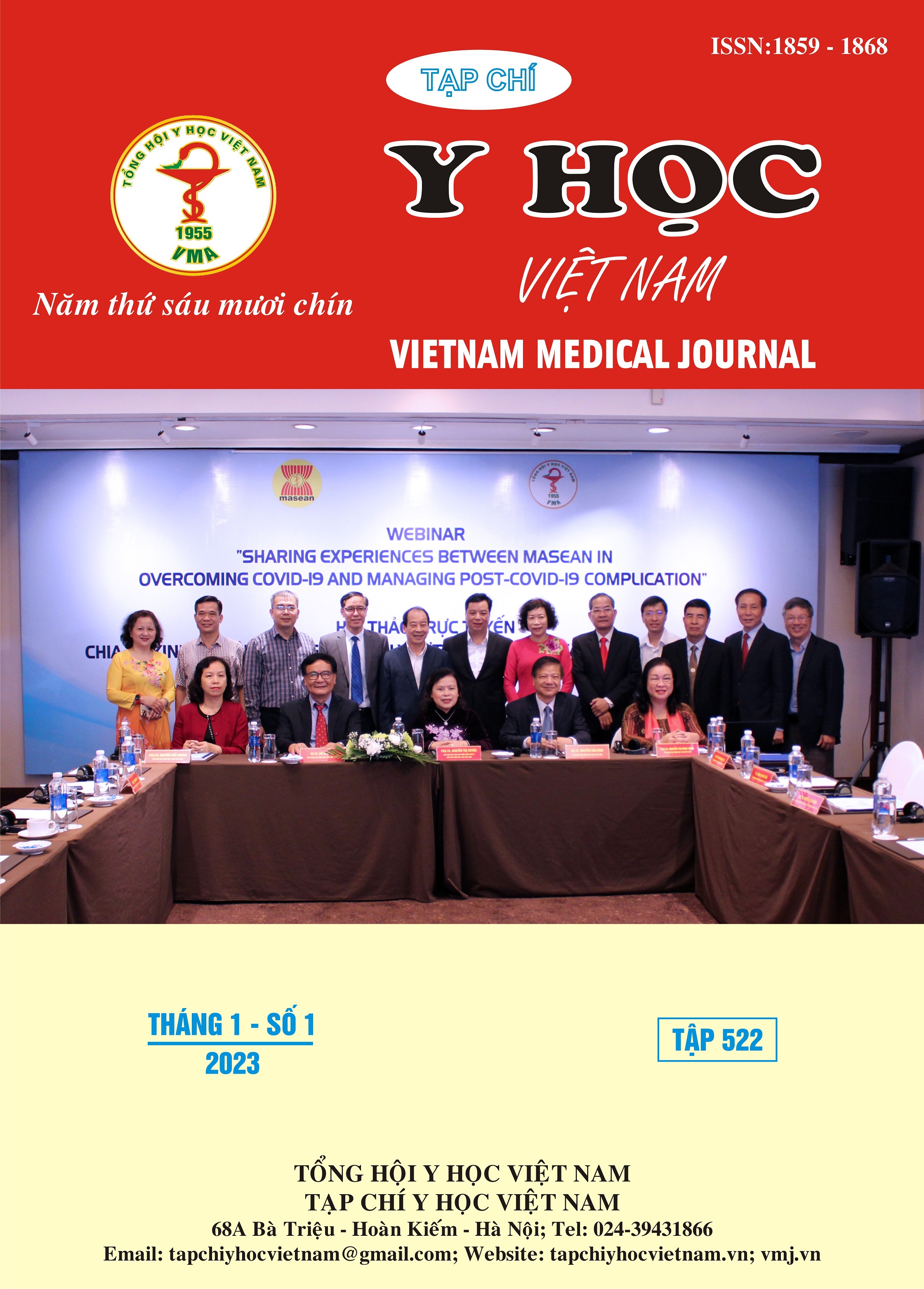ĐẶC ĐIỂM KHÁNG KHÁNG SINH VÀ ĐẶC ĐIỂM DI TRUYỀN CỦA VI KHUẨN KHÁNG COLISTIN PHÂN LẬP TỪ THỊT GÀ, THỊT LỢN BÁN LẺ TẠI THÁI BÌNH
Nội dung chính của bài viết
Tóm tắt
Nghiên cứu được thực hiện nhằm đánh giá đặc điểm kháng kháng sinh và một số đặc điểm di truyền của các chủng vi khuẩn Gram âm kháng colistin phân lập từ thịt gà và thịt lợn bán lẻ tại Thái Bình trong giai đoạn 2018 - 2019. Bốn mươi tám chủng vi khuẩn Gram âm kháng colistin (nồng độ ức chế tối thiểu MIC ≥ 4 mg/L) được đánh giá độ nhạy cảm kháng sinh theo phương pháp khoanh giấy khuếch tán, phát hiện gen kháng colistin mcr bằng kỹ thuật multiplex PCR và phân tích liên quan di truyền bằng kỹ thuật điện di xung trường (PFGE). Kết quả cho thấy các vi khuẩn Gram âm kháng colistin có tỷ lệ kháng tương đối cao với một số kháng sinh như ampicillin, chloramphenicol, tetracycline, sulfamethoxazole –trimethoprim, nalidixic acid, tuy nhiên vẫn còn nhạy cảm với các kháng sinh fosfomycin, meropenem, ceftazidime và cefoxitin. Tỷ lệ kháng đa thuốc ở các vi khuẩn Gram âm kháng colistin là 72,9%. Kết quả cũng cho thấy có 21/48 chủng (43,8%) mang gen mcr-1 và không phát hiện các gen từ mcr-2 đến mcr-5. Tỷ lệ mẫu thịt gà và thịt lợn nhiễm vi khuẩn Gram âm mang gen mcr-1 lần lượt là 73,3% và 33,3%. Kết quả nghiên cứu cho thấy vi khuẩn Gram âm mang gen kháng colistin mcr-1 thường xuyên lây nhiễm trong các mẫu thịt gà, thịt lợn bán lẻ tại Thái Bình. Do đó, cần thực hiện các biện pháp can thiệp phù hợp nhằm ngăn chặn sự xuất hiện và lây lan của các vi khuẩn Gram âm kháng colistin ở thực phẩm, vật nuôi và con người.
Chi tiết bài viết
Từ khóa
gen mcr, kháng colistin, thịt gà, thịt lợn
Tài liệu tham khảo
1. Nguyễn Nam Thắng, Phan Ngọc Quang, Trần Thị Hòa và cộng sự (2018). Phát hiện gen mã hóa ESBL và gen kháng colistin ở vi khuẩn E. coli sinh ESBL phân lập từ một số thực phẩm có nguồn gốc động vật tại Thái Bình. Tạp chí Y học Việt Nam, tập 469, tr. 490 – 498.
2. CLSI. Performance Standards for Antimicrobial Susceptibility Testing, 30th edition - M100, 2020.
3. Kawahara, R., Fujiya, Y., Yamaguchi, T., et al. (2019). Most Domestic Livestock Possess Colistin-Resistant Commensal Escherichia coli Harboring mcr in a Rural Community in Vietnam. Antimicrobial agents and chemotherapy, 63(6), e00594-19.
4. Liu, Y. Y., Wang, Y., Walsh, T. R., et al. (2016). Emergence of plasmid-mediated colistin resistance mechanism MCR-1 in animals and human beings in China: a microbiological and molecular biological study. The Lancet. Infectious diseases, 16(2), 161–168.
5. Magiorakos, A. P., Srinivasan, A., Carey, R. B., et al. (2012). Multidrug-resistant, extensively drug-resistant and pandrug-resistant bacteria: an international expert proposal for interim standard definitions for acquired resistance. Clinical microbiology and infection: the official publication of the European Society of Clinical Microbiology and Infectious Diseases, 18(3), 268–281.
6. Nakayama, T., Jinnai, M., Kawahara, R., et al. (2017). Frequent use of colistin-based drug treatment to eliminate extended-spectrum beta-lactamase-producing Escherichia coli in backyard chicken farms in Thai Binh Province, Vietnam. Tropical animal health and production, 49(1), 31–37.
7. Yamaguchi, T., Kawahara, R., Harada, K., et al. (2018). The presence of colistin resistance gene mcr-1 and -3 in ESBL producing Escherichia coli isolated from food in Ho Chi Minh City, Vietnam. FEMS microbiology letters, 365(11), 10.1093/femsle/fny100.
8. Yamamoto, Y., Kawahara, R., Fujiya, Y., et al. (2019). Wide dissemination of colistin-resistant Escherichia coli with the mobile resistance gene mcr in healthy residents in Vietnam. The Journal of antimicrobial chemotherapy, 74(2), 523–524.
2. CLSI. Performance Standards for Antimicrobial Susceptibility Testing, 30th edition - M100, 2020.
3. Kawahara, R., Fujiya, Y., Yamaguchi, T., et al. (2019). Most Domestic Livestock Possess Colistin-Resistant Commensal Escherichia coli Harboring mcr in a Rural Community in Vietnam. Antimicrobial agents and chemotherapy, 63(6), e00594-19.
4. Liu, Y. Y., Wang, Y., Walsh, T. R., et al. (2016). Emergence of plasmid-mediated colistin resistance mechanism MCR-1 in animals and human beings in China: a microbiological and molecular biological study. The Lancet. Infectious diseases, 16(2), 161–168.
5. Magiorakos, A. P., Srinivasan, A., Carey, R. B., et al. (2012). Multidrug-resistant, extensively drug-resistant and pandrug-resistant bacteria: an international expert proposal for interim standard definitions for acquired resistance. Clinical microbiology and infection: the official publication of the European Society of Clinical Microbiology and Infectious Diseases, 18(3), 268–281.
6. Nakayama, T., Jinnai, M., Kawahara, R., et al. (2017). Frequent use of colistin-based drug treatment to eliminate extended-spectrum beta-lactamase-producing Escherichia coli in backyard chicken farms in Thai Binh Province, Vietnam. Tropical animal health and production, 49(1), 31–37.
7. Yamaguchi, T., Kawahara, R., Harada, K., et al. (2018). The presence of colistin resistance gene mcr-1 and -3 in ESBL producing Escherichia coli isolated from food in Ho Chi Minh City, Vietnam. FEMS microbiology letters, 365(11), 10.1093/femsle/fny100.
8. Yamamoto, Y., Kawahara, R., Fujiya, Y., et al. (2019). Wide dissemination of colistin-resistant Escherichia coli with the mobile resistance gene mcr in healthy residents in Vietnam. The Journal of antimicrobial chemotherapy, 74(2), 523–524.


